
Hydroponics is a type of horticulture and a subset of hydroculture which involves growing plants, usually crops or medicinal plants, without soil, by using water-based mineral nutrient solutions in an artificial environment. Terrestrial or aquatic plants may grow freely with their roots exposed to the nutritious liquid or the roots may be mechanically supported by an inert medium such as perlite, gravel, or other substrates.
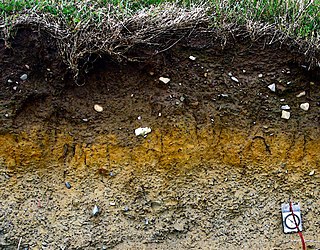
Soil, also commonly referred to as earth or dirt, is a mixture of organic matter, minerals, gases, liquids, and organisms that together support the life of plants and soil organisms. Some scientific definitions distinguish dirt from soil by restricting the former term specifically to displaced soil.
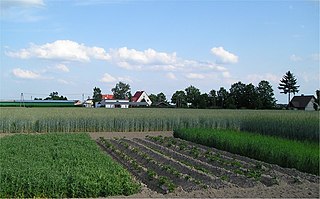
Crop rotation is the practice of growing a series of different types of crops in the same area across a sequence of growing seasons. This practice reduces the reliance of crops on one set of nutrients, pest and weed pressure, along with the probability of developing resistant pests and weeds.
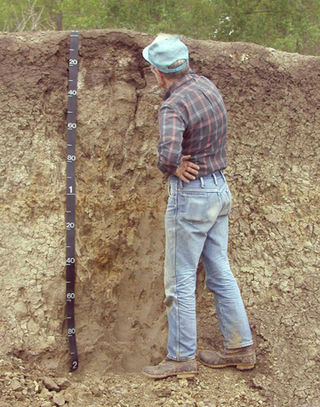
Soil science is the study of soil as a natural resource on the surface of the Earth including soil formation, classification and mapping; physical, chemical, biological, and fertility properties of soils; and these properties in relation to the use and management of soils.

Agronomy is the science and technology of producing and using plants by agriculture for food, fuel, fiber, chemicals, recreation, or land conservation. Agronomy has come to include research of plant genetics, plant physiology, meteorology, and soil science. It is the application of a combination of sciences such as biology, chemistry, economics, ecology, earth science, and genetics. Professionals of agronomy are termed agronomists.

Topsoil is the upper layer of soil. It has the highest concentration of organic matter and microorganisms and is where most of the Earth's biological soil activity occurs.

Soil fertility refers to the ability of soil to sustain agricultural plant growth, i.e. to provide plant habitat and result in sustained and consistent yields of high quality. It also refers to the soil's ability to supply plant/crop nutrients in the right quantities and qualities over a sustained period of time. A fertile soil has the following properties:
Tilth is a physical condition of soil, especially in relation to its suitability for planting or growing a crop. Factors that determine tilth include the formation and stability of aggregated soil particles, moisture content, degree of aeration, soil biota, rate of water infiltration and drainage. Tilth can change rapidly, depending on environmental factors such as changes in moisture, tillage and soil amendments. The objective of tillage is to improve tilth, thereby increasing crop production; in the long term, however, conventional tillage, especially plowing, often has the opposite effect, causing the soil carbon sponge to oxidize, break down and become compacted.
A soil conditioner is a product which is added to soil to improve the soil’s physical qualities, usually its fertility and sometimes its mechanics. In general usage, the term "soil conditioner" is often thought of as a subset of the category soil amendments, which more often is understood to include a wide range of fertilizers and non-organic materials. In the context of construction soil conditioning is also called soil stabilization.
Edaphology is concerned with the influence of soils on living beings, particularly plants. It is one of two main divisions of soil science, the other being pedology. Edaphology includes the study of how soil influences humankind's use of land for plant growth as well as people's overall use of the land. General subfields within edaphology are agricultural soil science and environmental soil science.
Soil chemistry is the study of the chemical characteristics of soil. Soil chemistry is affected by mineral composition, organic matter and environmental factors. In the early 1870s a consulting chemist to the Royal Agricultural Society in England, named J. Thomas Way, performed many experiments on how soils exchange ions, and is considered the father of soil chemistry. Other scientists who contributed to this branch of ecology include Edmund Ruffin, and Linus Pauling.
Soil health is a state of a soil meeting its range of ecosystem functions as appropriate to its environment. In more colloquial terms, the health of soil arises from favorable interactions of all soil components that belong together, as in microbiota, plants and animals. It is possible that a soil can be healthy in terms of ecosystem functioning but not necessarily serve crop production or human nutrition directly, hence the scientific debate on terms and measurements.
Soil biodiversity refers to the relationship of soil to biodiversity and to aspects of the soil that can be managed in relative to biodiversity. Soil biodiversity relates to some catchment management considerations.
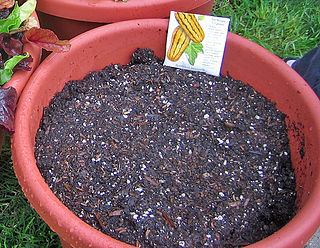
Potting soil or growing media, also known as potting mix or potting compost (UK), is a substrate used to grow plants in containers. The first recorded use of the term is from an 1861 issue of the American Agriculturist. Despite its name, little or no soil is usually used in potting soil.
The term cropping system refers to the crops, crop sequences and management techniques used on a particular agricultural field over a period of years. It includes all spatial and temporal aspects of managing an agricultural system. Historically, cropping systems have been designed to maximise yield, but modern agriculture is increasingly concerned with promoting environmental sustainability in cropping systems.

Base-cation saturation ratio (BCSR) is a method of interpreting soil test results that is widely used in sustainable agriculture, supported by the National Sustainable Agriculture Information Service (ATTRA) and claimed to be successfully in use on over a million acres (4,000 km2) of farmland worldwide. The traditional method, as used by most university laboratories, is known variously as the 'sufficiency level', sufficiency level of available nutrients (SLAN), or Index(UK) system. The sufficiency level system is concerned only with keeping plant-available nutrient levels within a well studied range, making sure there is neither a deficiency nor an excess. In the BCSR system, soil cations are balanced according to varying ratios often stated as giving 'ideal' or 'balanced' soil. These ratios can be between individual cations, such as the calcium to magnesium ratio, or they may be expressed as a percentage saturation of the cation exchange capacity (CEC) of the soil. Most 'ideal soil' theories stress both approaches.
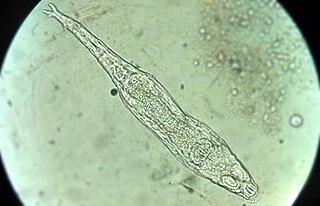
Soil mesofauna are invertebrates between 0.1mm and 2mm in size, which live in the soil or in a leaf litter layer on the soil surface. Members of this group include nematodes, mites, springtails (collembola), proturans, pauropods, rotifers, earthworms, tardigrades, small spiders, pseudoscorpions, opiliones (harvestmen), enchytraeidae such as potworms, insect larvae, small isopods and myriapods. They play an important part in the carbon cycle and are likely to be adversely affected by climate change.

Soil compaction, also known as soil structure degradation, is the increase of bulk density or decrease in porosity of soil due to externally or internally applied loads. Compaction can adversely affect nearly all physical, chemical and biological properties and functions of soil. Together with soil erosion, it is regarded as the "costliest and most serious environmental problem caused by conventional agriculture."

Soil regeneration, as a particular form of ecological regeneration within the field of restoration ecology, is creating new soil and rejuvenating soil health by: minimizing the loss of topsoil, retaining more carbon than is depleted, boosting biodiversity, and maintaining proper water and nutrient cycling. This has many benefits, such as: soil sequestration of carbon in response to a growing threat of climate change, a reduced risk of soil erosion, and increased overall soil resilience.

Soil aggregate stability is a measure of the ability of soil aggregates—soil particles that bind together—to resist breaking apart when exposed to external forces such as water erosion and wind erosion, shrinking and swelling processes, and tillage. Soil aggregate stability is a measure of soil structure and can be affected by soil management.














